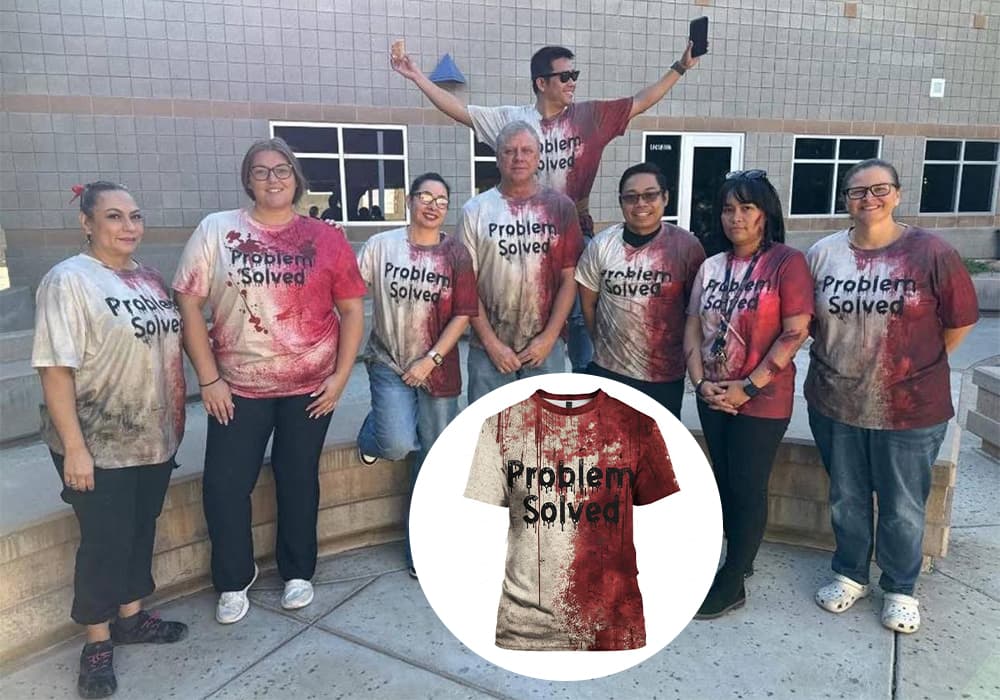Uncategorized
Problem Solved T-Shirt Meaning: Halloween Gag or Controversial Statement?
Have you ever spotted someone wearing a white T-shirt splashed with fake blood and the bold phrase “Problem Solved” dripping across it? At first glance, it might seem like a clever, spooky Halloween costume—perfect for parties or trick-or-treating. But dig a little deeper, and this seemingly innocent garment reveals layers of dark humor, irony, and even real-world controversy. In this post, we’ll explore what the “Problem Solved” T-shirt really means, from its playful origins to its more troubling implications, especially in light of recent events.
The Design and Appeal: A Bloody Halloween Classic
The “Problem Solved” T-shirt typically features a simple white base with the phrase printed in a gritty font, accompanied by realistic-looking blood splatters, handprints, or drips that give it a horror movie vibe. It’s marketed as a fun, edgy way to “solve” your costume dilemmas without much effort—just throw it on and you’re ready for a night of scares. The humor lies in the implication: whatever “problem” you had, it’s been dealt with in a gruesomely final manner, tapping into zombie apocalypse or slasher film tropes.
This shirt has become a staple for Halloween enthusiasts and horror fans, often praised for its ironic toughness. You can find variations of it on popular online retailers like Amazon, Etsy, and eBay. Sites like Fremontclothing and similar platforms offer it in various sizes, from S to XL, usually made from comfortable cotton blends. Some versions even include additional twists, like “I’m Fine, It’s Not My Blood” for extra dark comedy. It’s perfect for those who want a low-effort costume that still packs a punch.
The Controversial Side: When Humor Crosses the Line
The “Problem Solved” T-shirt’s violent imagery, suggesting a bloody fix to issues, has faced criticism since 2006 from groups fighting domestic violence, who see it as downplaying real harm and potentially encouraging aggressive attitudes. This view raises ongoing concerns about how edgy jokes can veer into poor taste, especially when evoking assault or murder.
In 2025, the shirt sparked major controversy at Cienega High School in Arizona’s Vail Unified School District. On Halloween, shortly after conservative activist Charlie Kirk’s September 10 assassination by a sniper at a Utah event, seven math staff members wore the shirts with red stains mimicking blood on the side matching Kirk’s wound. A group photo spread online, drawing sharp backlash for appearing to mock his death.
UPDATE: Vail Schools said these math teachers wore the same costume last year. I was waiting for confirmation, and it appears they did. I am updating the thread with the image. We've seen enough evil since Charlie's murder that I'd actually be relieved if this isn't another… https://t.co/pXjYiqofep pic.twitter.com/viQJYBsbIZ
— Andrew Kolvet (@AndrewKolvet) November 1, 2025
Arizona Rep. Rachel Keshel condemned the outfits as insensitive and a normalization of political violence, rejecting claims they were reused from prior years and demanding the staff’s dismissal to uphold school trust and safety. Turning Point USA’s Andrew Kolvet, a Kirk associate, agreed, pushing for their firing and doubting the school’s rationale.
The district issued a now-removed Facebook apology from Superintendent John Carruth, stating the shirts aimed to symbolize effort in math problem-solving without any political nod, and the photo was deleted. No further updates have followed.
This case illustrates the tricky balance between fun and offense in a divided society, where timing and visuals can turn a costume into a divisive symbol, prompting debates on expression, professionalism, and sensitivity amid grief.

